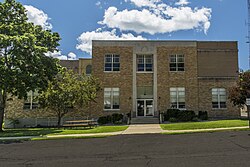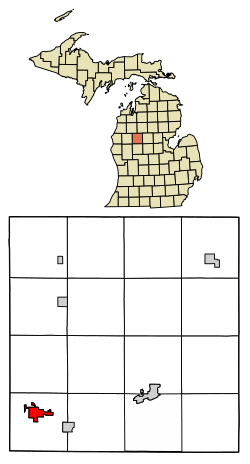Reed City, Michigan
City in Michigan, United States From Wikipedia, the free encyclopedia
City in Michigan, United States From Wikipedia, the free encyclopedia
Reed City is a city in the U.S. state of Michigan. The population was 2,490 at the 2020 census. It is located in southwestern Osceola County and is the county seat.[4]
Reed City, Michigan | |
|---|---|
 Osceola County Courthouse | |
| Motto: Your Crossroads Community on the Path to Progress... | |
 Location of Reed City, Michigan | |
| Coordinates: 43°52.5′N 85°30.6′W | |
| Country | United States |
| State | Michigan |
| County | Osceola |
| Area | |
| • Total | 2.13 sq mi (5.53 km2) |
| • Land | 2.10 sq mi (5.44 km2) |
| • Water | 0.03 sq mi (0.09 km2) |
| Elevation | 1,040 ft (317 m) |
| Population (2020) | |
| • Total | 2,490 |
| • Density | 1,184.59/sq mi (457.32/km2) |
| Time zone | UTC-5 (Eastern (EST)) |
| • Summer (DST) | UTC-4 (EDT) |
| ZIP code | 49677 |
| Area code | 231 |
| FIPS code | 26-67820[2] |
| GNIS feature ID | 1621363[3] |
According to the United States Census Bureau, the city has a total area of 2.11 square miles (5.46 km2), of which 2.08 square miles (5.39 km2) is land and 0.03 square miles (0.08 km2) is water.[5]
The Hersey River flows through Reed City.
At the 2020 census there were 2,465 people. The population density was 1,172.6 per square mile (452.7/km2).
At the 2010 census,[7] there were 2,425 people, 1,007 households, and 582 families living in the city. The population density was 1,165.9 per square mile (450.2/km2). There were 1,136 housing units at an average density of 546.2 per square mile (210.9/km2). The racial make-up of the city was 94.8% White, 1.7% African American, 0.5% Native American, 0.2% Asian, 0.3% from other races and 2.5% from two or more races. Hispanic or Latino of any race were 2.2% of the population.
There were 1,007 households, of which 33.3% had children under the age of 18 living with them, 35.3% were married couples living together, 16.8% had a female householder with no husband present, 5.8% had a male householder with no wife present, and 42.2% were non-families. 38.7% of all households were made up of individuals, and 15.6% had someone living alone who was 65 years of age or older. The average household size was 2.26 and the average family size was 2.98.
The median age was 36.1 years. 26.4% of residents were under the age of 18, 9.6% were between the ages of 18 and 24, 25.1% were from 25 to 44, 21.4% were from 45 to 64 and 17.5% were 65 years of age or older. The sex make-up of the city was 44.9% male and 55.1% female.
At the 2000 census,[2] there were 2,430 people, 999 households and 609 families living in the city. The population density was 1,265.3 per square mile (488.5/km2). There were 1,090 housing units at an average density of 567.5 per square mile (219.1/km2). The racial make-up was 95.84% White, 1.07% African American, 0.74% Native American, 0.21% Asian, 0.12% from other races, and 2.02% from two or more races. Hispanic or Latino of any race were 0.91% of the population.
There were 999 households, of which 31.2% had children under the age of 18 living with them, 40.2% were married couples living together, 16.4% had a female householder with no husband present, and 39.0% were non-families. 33.4% of all households were made up of individuals, and 14.4% had someone living alone who was 65 years of age or older. The average household size was 2.30 and the average family size was 2.93.
25.6% of the population were under the age of 18, 11.4% from 18 to 24, 25.4% from 25 to 44, 19.8% from 45 to 64 and 17.7% were 65 years of age or older. The median age was 36 years. For every 100 females, there were 84.2 males. For every 100 females age 18 and over, there were 80.8 males.
The median household income was $30,756 and the median family income was $42,340. Males had a median income of $29,375 and females $25,263. The per capita income was $15,889. About 10.9% of families and 17.9% of the population were below the poverty line, including 16.6% of those under age 18 and 14.2% of those age 65 or over.
The city is also at the crossroads of two US highways:
Indian Trails provides daily intercity bus service between Grand Rapids and Petoskey, Michigan.[8]
Two of the state's premier rail trails intersect in the city:
The Pennsylvania Railroad ran trains from Grand Rapids to Cadillac, Petoskey and Mackinaw City on a route that includes land used now for the White Pine Trail, making stops in Reed City's union station. Immediate connections in Grand Rapids with sleepers to eastern Indiana and Cincinnati were part of the schedule. Reed City was the closest PRR station to Idlewild, a significant African-American resort until the 1960s. In the final years, service through the town was reduced to summer only.[9] Passenger service ended between 1954 and 1955.[10]
The Pere Marquette Railway ran trains west from Reed City to Ludington and east to Saginaw, on a route that is included in the above cited rail trail. At Saginaw the trains were timed to meet with separate Bay City-originating trains to Detroit. The PM's successor, the Chesapeake and Ohio Railway, ended the Ludington to Saginaw trains in the latter months of 1949.[11]
Seamless Wikipedia browsing. On steroids.
Every time you click a link to Wikipedia, Wiktionary or Wikiquote in your browser's search results, it will show the modern Wikiwand interface.
Wikiwand extension is a five stars, simple, with minimum permission required to keep your browsing private, safe and transparent.